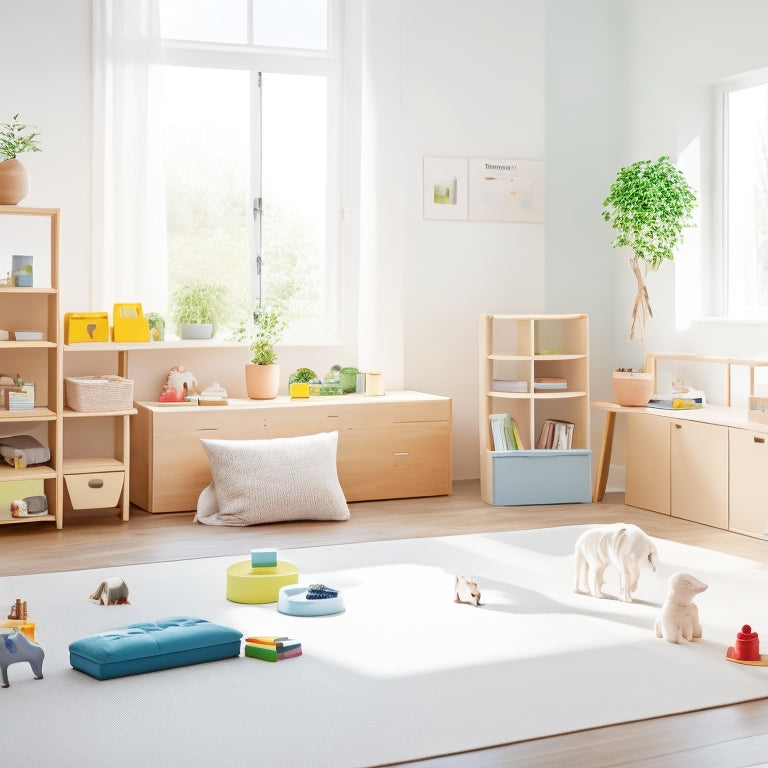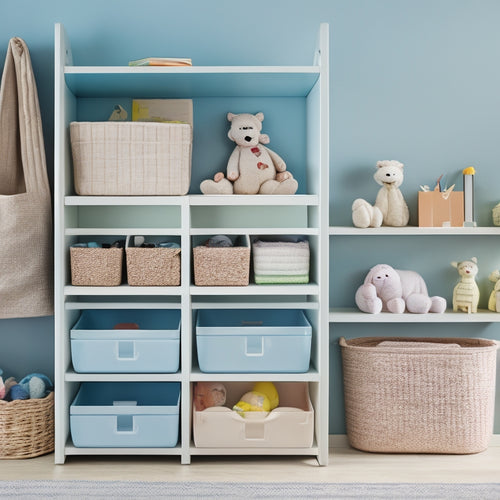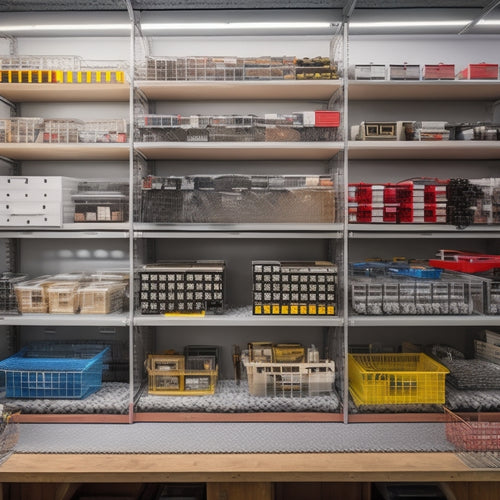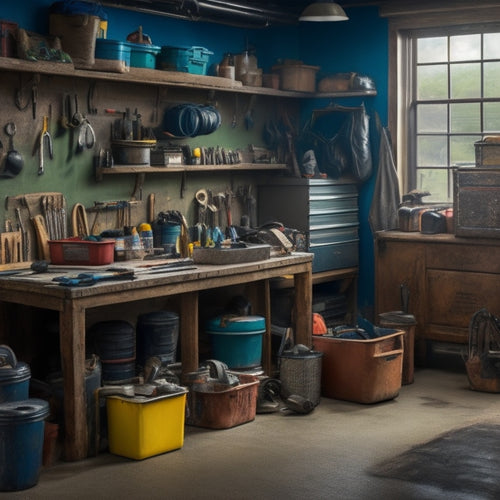
IKEA Montessori Marvels: Elevate Your Home Setup
Share
Elevate your home setup with IKEA's modular designs, perfectly aligned with Montessori principles. Create a child-centered space that fosters independence, respect, and continuous growth by prioritizing accessible storage, organized spaces, and educational toys. Curate a Montessori-inspired decor and incorporate low shelves for self-directed learning. Ingenious storage and organizational systems empower children to take ownership of their learning environment. By incorporating functional systems, creative play spaces, and efficient learning tools, you can unleash your child's full potential. As you explore the intersection of IKEA and Montessori, discover how to harmoniously blend style, functionality, and learning.
Key Takeaways
• Prioritize accessible storage and organized spaces using IKEA's modular shelving units to foster independence and continuous growth.
• Curate a child-centered space with Montessori decor and educational toys to encourage exploration and learning.
• Implement stylish organization systems like bins and baskets to empower children to cultivate personalized learning environments.
• Utilize space-saving solutions and modular shelving units to provide easy access to materials and facilitate independent learning.
• Design interactive play spaces with thoughtful furniture choices to encourage creativity, comfort, and self-expression in children.
Montessori Home Environment Essentials
When designing a Montessori-inspired home environment, it is essential to prioritize accessible storage and organized spaces that foster independence, respect, and continuous growth.
A well-curated Montessori decor sets the tone for a child-centered space, where educational toys and materials are thoughtfully displayed to encourage exploration and learning.
By incorporating low shelves and accessible storage, children can easily retrieve and return materials, promoting self-directed learning and responsibility.
This intentional design approach creates a sense of control and agency, allowing children to navigate their environment with confidence and autonomy.
Ingenious Storage and Organization
IKEA's modular shelving units and storage solutions harmonize seamlessly with Montessori principles, empowering children to cultivate responsibility and personalized learning environments. By incorporating stylish organization systems, such as bins, baskets, and wall-mounted solutions, you can create a space that promotes exploration and interaction while maintaining order.
Space-saving solutions like mobile storage units and cleverly designed trays keep essential materials within reach, encouraging children to take ownership of their belongings and develop good habits. These ingenious storage solutions not only enhance the aesthetic of your home but also foster a sense of independence and self-awareness in your child.
Functional Systems for Learning
In a Montessori-inspired environment, functional organizational systems play a pivotal role in facilitating independent learning and exploration. These systems provide children with accessible and organized materials that foster a sense of control and agency. They enable children to engage with interactive materials and educational tools, promoting self-directed learning and skill-building.
By incorporating functional systems, parents can create an environment that encourages children to take ownership of their learning process.
-
Utilize modular shelving units to categorize and display materials, making it easy for children to access and engage with them.
-
Implement trays and baskets to store puzzles, games, and activities, keeping them organized and within reach.
-
Incorporate mobile storage units and wall-mounted solutions to promote exploration and interaction while maintaining organization.
- Designate specific areas for various activities, such as reading nooks or art spaces, to create a sense of structure and routine.
Creative Play Spaces and Furniture
Crafting imaginative play spaces with thoughtful furniture selections can have a profound impact on a child's cognitive, emotional, and social development, as it encourages exploration, creativity, and self-expression.
IKEA's playroom essentials, such as the FLISAT Children's Table and Chairs, POÄNG Children's Armchair, and MÅLA Easel, promote creativity and comfort.
Designing interactive spaces with play essentials like the DUNDRA Play Table with Storage and KLIPSK Bed Tray offers versatile play and learning opportunities.
These furniture choices enable children to engage in imaginative play, fostering independence and self-expression. By intentionally selecting furniture that sparks creativity, parents can create a Montessori-inspired playroom that nurtures a child's natural curiosity and love for learning.
Efficient Learning and Independence
By incorporating cleverly designed storage solutions and organizational systems, parents can create a Montessori-inspired environment that fosters efficient learning and independence. This setup empowers children to take ownership of their learning process, making them more autonomous and self-directed.
With clever storage solutions, materials are easily accessible, encouraging children to explore and learn at their own pace.
- Modular shelving units and storage solutions support continuous growth and exploration
- Organizational systems like trays and bins promote responsibility and personalized learning environments
- Mobile and wall-mounted solutions encourage exploration and interaction while keeping essential materials within reach
- Specialized storage and displays enhance organization and engagement, leading to more efficient learning and independence
Sleeping Areas That Inspire
Three essential elements - a comfortable sleeping space, soft lighting, and child-led preparation - come together to create a sleeping area that inspires independence and self-care in children.
IKEA's UNDERLIG Mattress and LURÖY Slatted Bed Base provide the foundation for a dreamy sleepscape, while soft lighting sets the tone for bedtime bliss.
By empowering children to prepare their own sleeping area, they develop a sense of autonomy and responsibility.
Cozy corners and tranquil retreats can be created with clever use of storage solutions, such as bins and baskets, to maintain a clutter-free environment.
Empowering Children's Autonomy
In Montessori-inspired bedrooms, carefully designed sleeping areas can become a catalyst for empowering children's autonomy, as they learn to take ownership of their personal space and develop essential life skills. By providing a sense of control and agency, children can flourish and become more independent.
This is achieved by incorporating child-friendly features, such as low-height beds and accessible storage, that allow children to take care of their own needs.
- Encourage children to prepare their own sleeping area, promoting a sense of responsibility and self-care.
- Foster autonomy by providing choices, such as selecting their own bedding or decorations.
- Create a sense of ownership by involving children in the design and setup of their bedroom.
- Nurturing independence through Montessori principles helps children develop essential life skills, such as self-motivation and problem-solving.
Frequently Asked Questions
How Do I Balance Montessori Principles With Ikea's Modern Design Aesthetic?
Balancing Montessori principles with modern design aesthetic requires embracing Scandinavian simplicity, resolving design dilemmas by harmoniously integrating functional storage, and thoughtfully selecting furniture that promotes independence and self-directed learning.
Can I Adapt Montessori Storage Solutions for Children With Special Needs?
For children with special needs, adapt Montessori storage solutions by incorporating accessible shelving and adaptive furniture, ensuring easy reach and navigation, while promoting independence and autonomy in their learning environment.
Are Montessori-Inspired Spaces Suitable for Children of Different Ages and Stages?
'As the adage goes, 'children are the architects of their own learning.' Montessori-inspired spaces, tailored to age appropriateness, facilitate smooth toddler progressions, catering to diverse developmental stages, and fostering independence and self-directed exploration.'
How Often Should I Rotate Materials and Activities to Maintain Engagement and Interest?
To maintain engagement and interest, rotate materials and activities every 4-6 weeks, aligning with seasonal refreshes and learning cycles, allowing children to explore new concepts and build upon previous knowledge in a balanced and engaging environment.
Can I Incorporate Technology, Like Tablets and Educational Apps, Into a Montessori Setup?
According to a Pew Research study, 98% of parents with children under 8 use digital devices to keep them occupied. In a Montessori setup, incorporate technology thoughtfully by setting Digital Boundaries and limiting Screen Time to establish a balanced learning environment.
Related Posts
-

Storage Bins for Shelves to Keep Clutter at Bay
You're looking for a way to keep your shelves organized and clutter-free, and storage bins are the perfect solution t...
-

10 Essential Steps for Small Parts Bin Storage
To optimize your small parts bin storage, start by defining your storage needs and goals, considering factors like av...
-

Best Cheap Tool Boxes for Budget-Conscious Buyers
You need a reliable tool box that gets the job done without breaking the bank. Look for durable materials, rust-resis...


